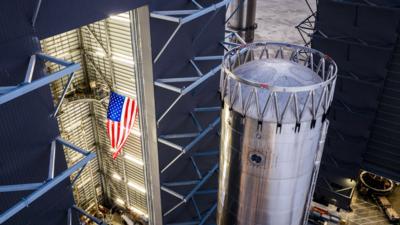Wed, Nov 26, 2025
Booster 18 Experienced a Major Structural Failure During Initial Tests
A day after its Starship Version 3 booster experienced an abrupt structural failure, SpaceX took to social media to share that it was both a blessing and a curse that the incident happened so early into testing. Engines had yet to be installed, no propellant was on board, and all personnel were stationed safely away from the facility.

“Booster 18 suffered an anomaly during gas system pressure testing that we were conducting in advance of structural proof testing,” SpaceX’s statement read. “The teams need time to investigate before we are confident of the cause. No one was injured as we maintain a safe distance for personnel during this type of testing. The site remains clear and we are working plans to safely reenter the site.”
Just after 4:00 am on its first night of gas-system pressure tests at the company’s Massey facility in Starbase, Texas, the booster’s lower section crumpled inward around the liquid oxygen tank. Photos from observers later in the morning revealed widespread deformation along the vehicle’s base. The immediate verdict was that Booster 18 is almost certainly a total loss.
The timing makes the setback sting a bit more. Booster 18 had only rolled out a day earlier and represented the debut hardware of the long-anticipated Starship V3 line. It aimed to address structural and reliability shortcomings found in previous boosters, with improvements centering on enabling more frequent flights, shorter downtime between reuse, and tower-catch recovery. Elon Musk has even publicly positioned the V3 series as a step toward Mars.

Safe to say that it won’t be getting there anytime soon… especially with the booster’s campaign screeching to a halt before sunrise. If there’s a silver lining, however, it’s that the damage appears confined largely to the booster itself. The incident did not share the fire or infrastructure destruction with June’s upper-stage explosion at the same test site.
Still, SpaceX is operating on an already ambitious timeline. The company needs Starship flying regularly and reliably to support booster landings, Starlink deployment flights, and NASA’s near-term Artemis obligations. Those include an on-orbit refueling demonstration scheduled for late 2026 and crewed lunar support in 2027.
More News
From 2016 (YouTube Edition): The Canadian Forces Snowbirds Can Best Be Described As ‘Elegant’… EAA AirVenture 2016 was a great show and, in no small part, it was>[...]
Airplane Lunged Forward When It Was Stuck From Behind By A Tug That Was Towing An Unoccupied Airliner Analysis: At the conclusion of the air taxi flight, the flight crew were taxii>[...]
Aero Linx: International Stinson Club So you want to buy a Stinson. Well the Stinson is a GREAT value aircraft. The goal of the International Stinson Club is to preserve informatio>[...]
Request Full Route Clearance Used by pilots to request that the entire route of flight be read verbatim in an ATC clearance. Such request should be made to preclude receiving an AT>[...]
"Today's battlefield is adapting rapidly. By teaching our soldiers to understand how drones work and are built, we are giving them the skills to think creatively and apply emerging>[...]
 Classic Aero-TV: Pure Aerial Precision - The Snowbirds at AirVenture 2016
Classic Aero-TV: Pure Aerial Precision - The Snowbirds at AirVenture 2016 NTSB Final Report: Costruzioni Aeronautiche Tecna P2012 Traveller
NTSB Final Report: Costruzioni Aeronautiche Tecna P2012 Traveller ANN's Daily Aero-Linx (11.23.25)
ANN's Daily Aero-Linx (11.23.25) ANN's Daily Aero-Term (11.23.25): Request Full Route Clearance
ANN's Daily Aero-Term (11.23.25): Request Full Route Clearance Aero-News: Quote of the Day (11.23.25)
Aero-News: Quote of the Day (11.23.25)




